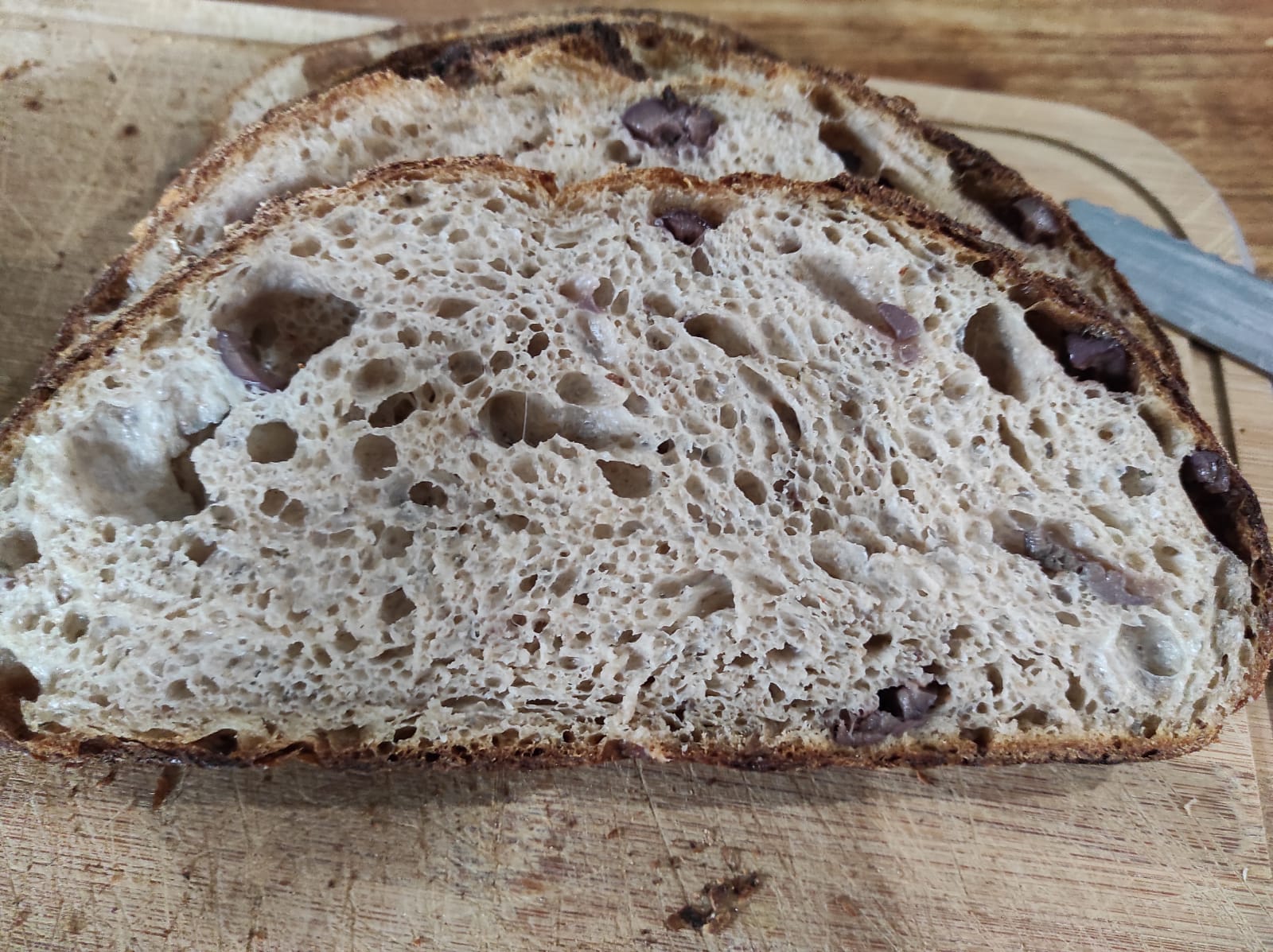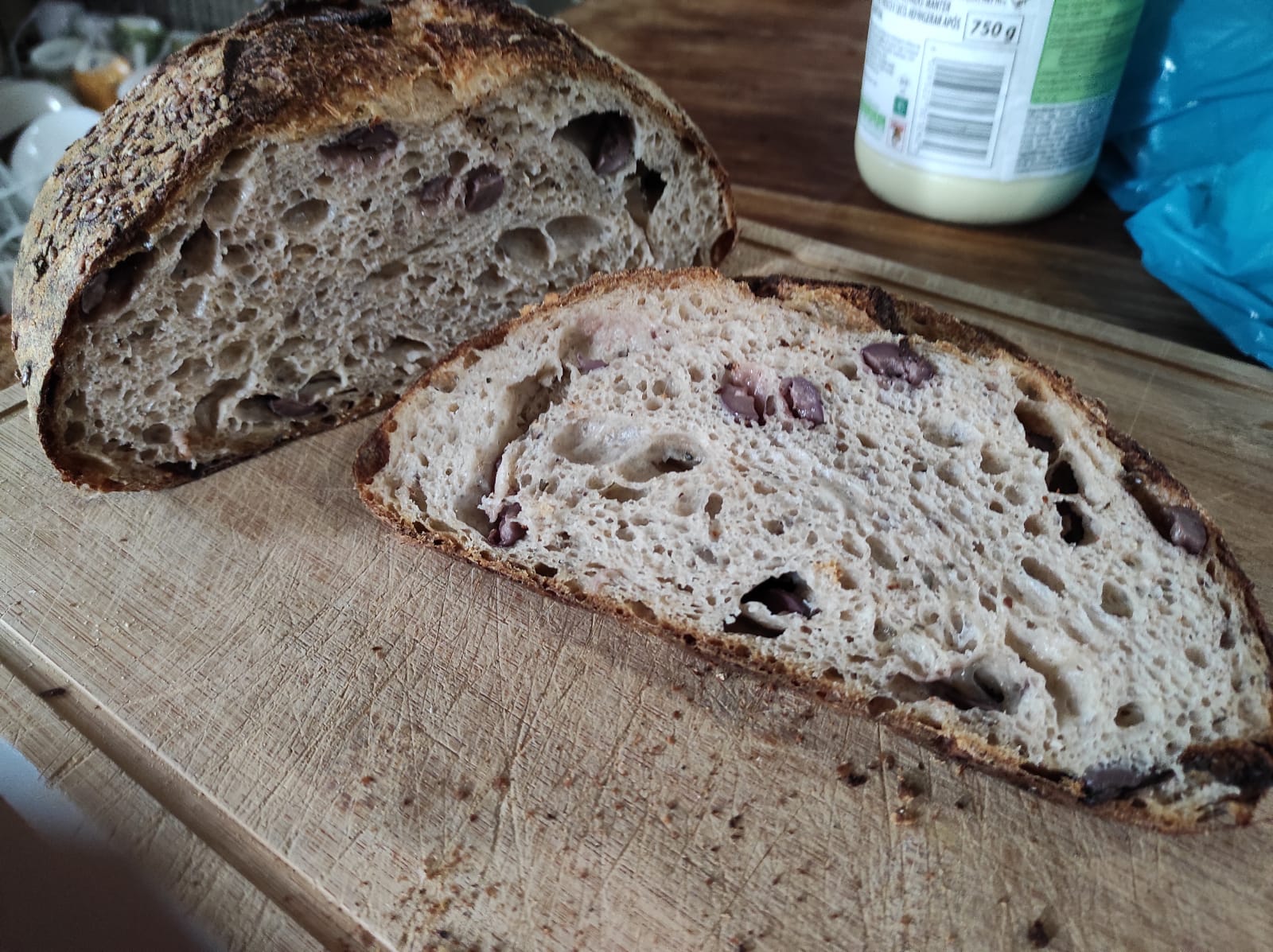So, there was this thing that Don said the other day in a TFL blog post that really got me thinking. Think it was a quote from Jennifer Lathams about tweaks to the Tartine bakery method, and the thing that was said was "[...] longer includes the leaven in the autolyse and salt is not added until enough water has been incorporated to make a very extensible dough."
I think I've been doing bassinage wrong! I usually try it after the salt is already in the dough.
This weekend's loaf came out surprisingly well when I left the salt out until the end. After a one hour autolyse I incorporated levain with the machine mixer (only about 3 minutes, the last two minutes on speed 2 of the Kenwood), and the mixer bowl was staying clean after the mix and could feel the dough was already nice and taut and felt like it had some strength. Then by hand I spent ten minutes adding the additional bassinage water 10g at a time by means of what I would describe as 'circular' stretch and folds turning the bowl as I did it. And then, using the same method by hand another 3 minutes to incorporate the salt. And it worked so well. Sometimes you can tell the dough is going to bake well, and it stretched out beautifully when I laminated the olives in.
The loaf is a little darker than I wanted (probably from the 1% baker's malt) but the eating was great - sometimes the stars align and I get that great crust and soft crumb and this was one of those days! It does feel like the stars are aligning more frequently recently, but it might just be my mixer! Unless I've actually stumbled upon something that can be repeated with the mix by machine, bassinage by hand and add salt after method. Will only know next time I bake, but the old hands here are probably getting ready to tell me of even better ways to do the bassinage.

The scoring was a simple cross, I didn't want to jinx things and get a flat loaf as I did let the aliquot jar show an 80% increase (shaping at 50%) and was afraid it would flatten in the oven, but oven spring was good too.


- JonJ's Blog
- Log in or register to post comments
Recipe details: 80% final hydration (70% at the time of machine mixing), using the Full Proof open crumb method as a base but scaled up to make a larger loaf, and I did deviate a bit with the method - mostly around the steps of machine mixing, bassinage and salt over a period of 20 minutes; plus addition of malt is also a deviation.
4g malt; 298g bread flour - 11.4% protein; 16g vital wheat gluten to compensate for this weaker flour and higher hydration; 86g unsifted wholewheat flour; 270g water initially, additional 41g added via bassinage for a total of 311g water; 9g salt; 80g levain that was double fed - the levain was 50% wholewheat/50% bread flour and was 5 hours old and the final feed was 1:2:2 five hours before using in the dough. Added 11 olives and some origanum during the lamination, but didn't weigh the inclusions.
1 hour autolyse. Followed by 20 minutes: incorporating levain by machine then immediately bassinage by hand to increase the hydration to 80% and then followed by the addition of the salt by hand. 45 minutes later olives laminated in. 3 sets of coil folds 1 hour apart; final shaping at 50% aliquot rise 5 hours after adding levain. Proofed further at room temp for 40 minutes and then into fridge for cold retard at (5 degrees C) - aliquot at 80% rise when it went into the fridge.
Baked at 260 deg C covered for 24 minutes and 230 deg C uncovered for a further 16 minutes. Then left in the oven with the door ajar for 15 minutes further.
Beautiful loaf Jon, so well done. I like the dark colour of the crust and find that it enhances the flavors. The fermentation looks great.
It will be interesting if you find in the long run that there is an advantage to doing the bassinage before the salt. Because I’m doing saltolyse that never happens in my kitchen,.
Benny
Lots of bakers with way more knowledge than me say that adding salt has a tightening effect on the gluten but it is not detrimental to the yeast and should be added early to make adjustments to the hydration. The salt in Benito's "saltolyse" is to prevent a long autolyse from fermenting into a starter. I think Jennifer holds it back to get a true judge of the extensibility of the dough without that tightening effect of the salt. What I gleaned from her post is that the bassinage is the best way to up the hydration gradually in stages for a Tartine style loaf because if you add too much water too early the dough is too loose to develop the gluten properly. I did another loaf this past weekend to confirm some things that she says and the difference it has made in my bread has been substantial. I have long been a proponent of high hydration but until recently I realized that I had not been adding enough water. The Tartine and Fullproof breads are all well above 80% water and the trick was getting that water into the dough without it turning soupy. As the gluten slowly develops it is able to take on more water. I have been amazed that the volume, texture, crumb as well as the crust are vastly better because of adding even more water. It's the fermentation that adds the strength to the dough.
Your bread looks great by the way and the glossy custard like softness of the crumb is apparent. What I am trying to understand is how we both got a crust that is so much more enjoyable than the old ways of doing things.